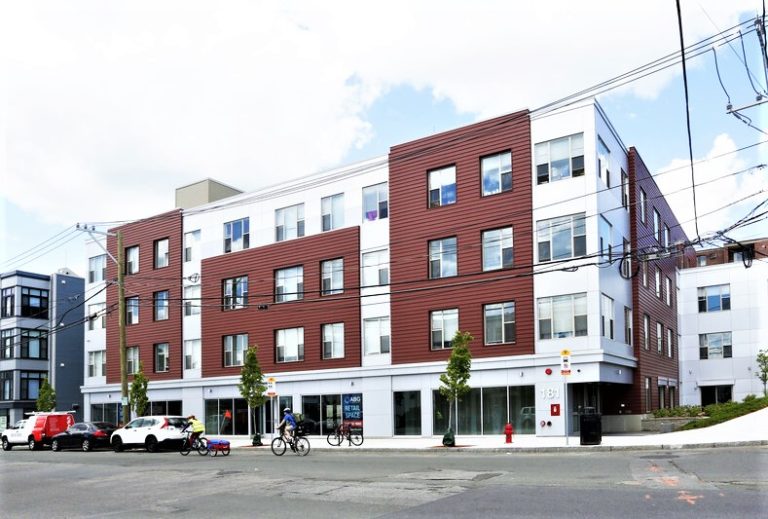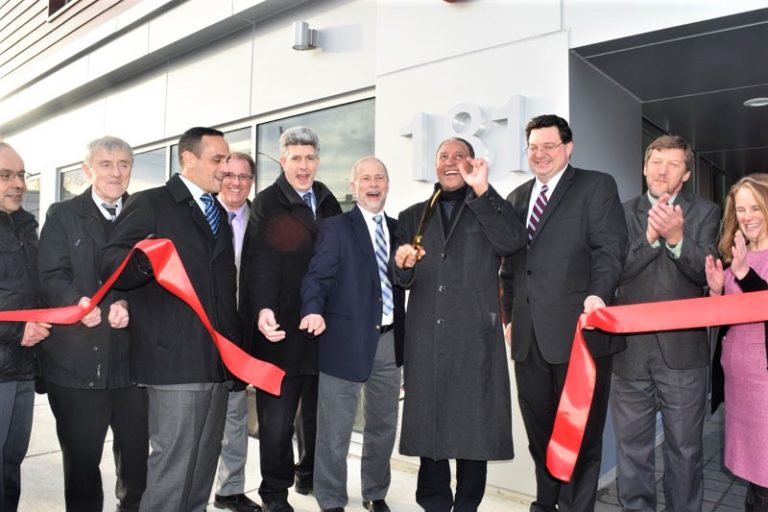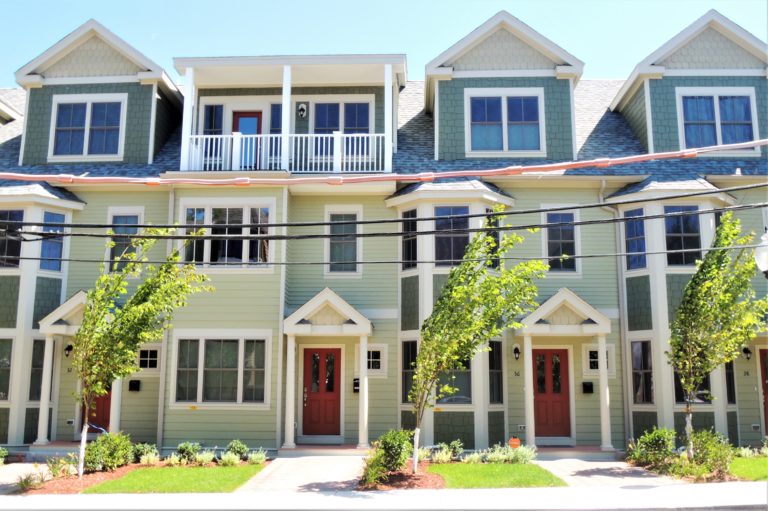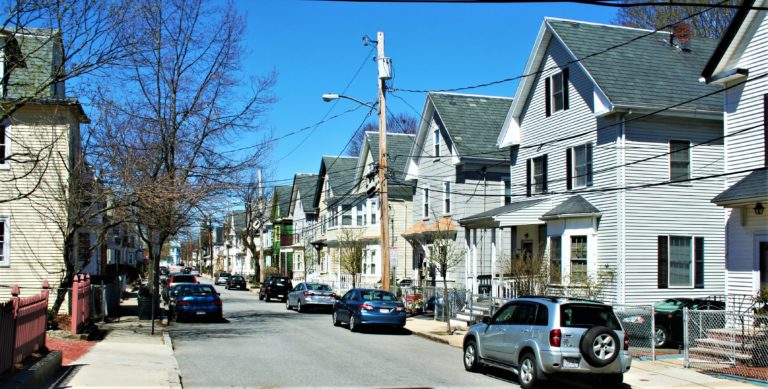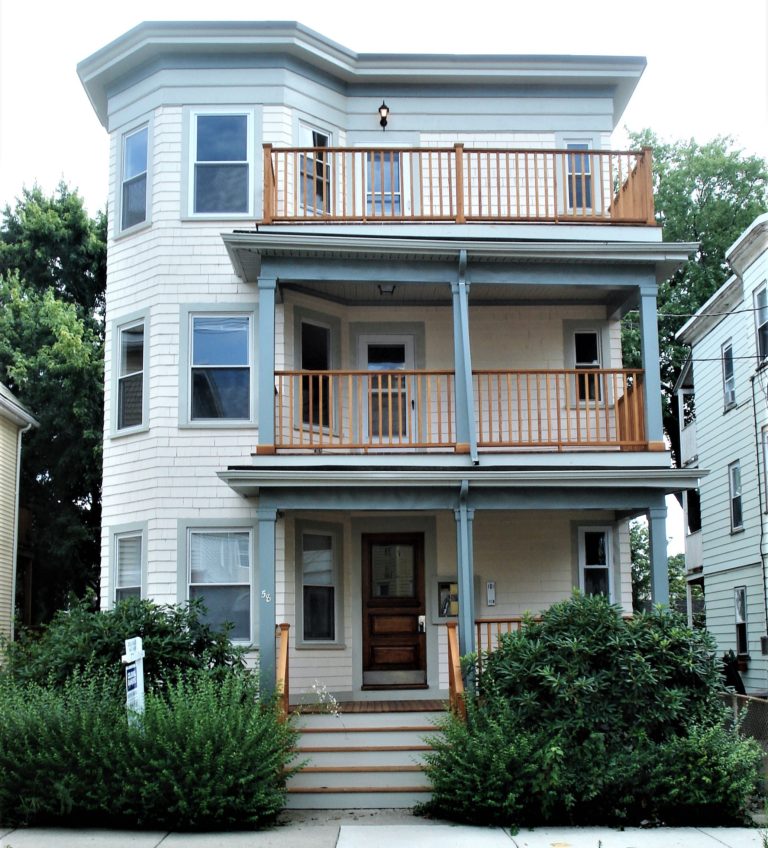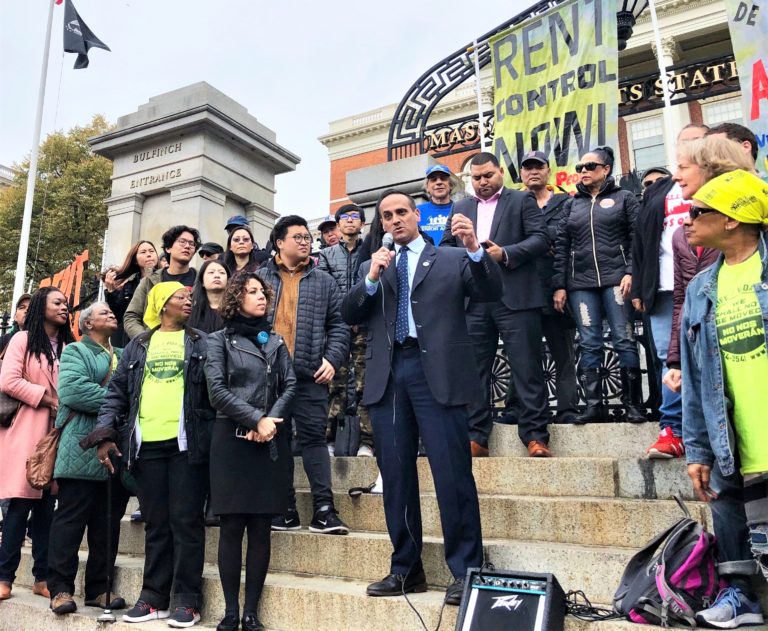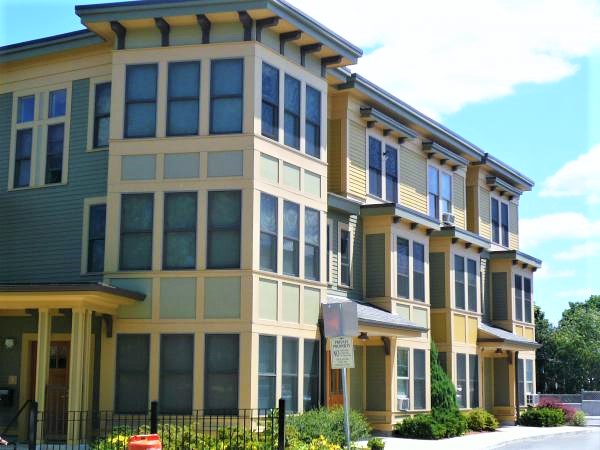SomerVision Number
in perpetuity by 2040
The scope of the Housing topic chapter is: affordable housing, housing for low and middle incomes, housing production, displacement, housing insecurity, and housing discrimination.
A household is considered rent-burdened, or cost-burdened by rent, when the rent takes up more than 30% of a household’s income. In 2017, according to ACS data, of those households making under $50,000 more than 80% of them were cost-burdened. This income bracket is one third of Somerville’s renter population. When households are cost burdened, its more likely that people are having to choose which bills to pay or what food to put on the table. In addition, unexpected expenses can be disasterous to the household.
A discussion point amongst the SVC working groups including the Commercial, Business, and Arts and Housing groups was the available jobs to the cost of housing. Many of the jobs that have been added in Somerville do not pay enough for employees to afford housing in Somerville. In particular, the food service and retail sectors.
STRENGTHS
The phrase “housing crisis,” unfortunately, rings close to home for many of the residents of Somerville. The challenges in solving this problem are multifaceted. We will leverage our strengths to rise up to this challenge.
Somerville is a diverse, vibrant, and welcoming place to live. Our community is very involved and many have come out in support of various efforts to make Somerville more accessible and affordable in multiple ways.
We are lucky that in addition to the robust civil society Somerville itself has to offer, our close proximity to the schools and industries of Boston and Cambridge also make Somerville a highly desirable destination. This is further supported by good public transportation (set to be further enhanced by the Green Line Extension).
In addition, Somerville already has a remarkable track record in advancing progressive housing policies, for example: Inclusionary Zoning, the Condominium Conversion Ordinance, the Community Preservation Act, and the Community Land Trust. Somerville also has an administration, city council, and constituents interested in doing more.
CHALLENGES & OPPORTUNITIES
There are six main housing-related challenges facing the city: the rising cost of housing, the lack of affordable housing, forced displacement, chronic homelessness, an insufficient diversity of housing stock, and an inadequate condition of the existing housing stock. This section 1 ACS 2010 and 2017 1-year estimatesprovides background on each of the challenges, while in the next section we describe goals to address each of the challenges.
Dramatic increases in housing costs are reshaping Somerville. Between 2010 and 2017, median rent in Somerville increased by ~29%1. Currently, about 35% of renter households are cost-burdened, and this is expected to increase. Rent increases have hit the lowest-income Somerville residents especially hard: more than 80% of them are cost-burdened, leaving very little left over for other necessities. To learn more, see the callout on the next page.
The median sale price of houses roughly doubled between 2010 and 2018. These prices have generally been beneficial or existing homeowners, but they have limited the possibility of purchasing a home in Somerville to only the upper class.
Somerville is anticipated to grow: the latest Metropolitan Area Planning Council (MAPC) projection shows an increase in population of ~13,000 (~15%) between 2017 and 20302. This corresponds to approximately 5,500 new housing units that have to be built just to satisfy an increase in population (assuming the household size remains at the current level of ~2.37). Even more housing will be needed to potentially slow the increase in housing prices. It is important to note that Somerville represents just a small part of Greater Boston, and thus can only succeed if there is effort from the whole region. Notably, the Metro Mayors Coalition entered a pledge to add 185,000 new housing units across the region by 20303.
Only about 10% of units in Somerville are currently deed restricted affordable. For comparison, Boston has 19% and Cambridge has about 15%4. Very few units are “naturally affordable” anymore, so if Somerville is to remain accessible to low- and middle-income residents, the city will have to increase the proportion of subsidized units.
Since SomerVision 2030, an important update to the Inclusionary Zoning requirement was passed that raised the minimum requirement for inclusionary zoning to 20% in most new developments. This increase is important, but alone is insufficient. Though Somerville is adding new units that are subsidized, other units’ subsidies are expiring, and unsubsidized units are continually becoming more and more unaffordable.
In addition, there are very few mechanisms to produce new units that are affordable to residents whose incomes are extremely low, defined as at or below 30% Area Median Income (AMI). Residents who have extremely low incomes do not qualify for inclusionary units unless they already have a housing voucher – something that often takes years to obtain. New affordable units made affordable through tax credits generally have rents targeted to those at 60% of AMI. The lack of creation of new units affordable to those with extremely low incomes poses a major barrier to accessing stable, affordable housing within Somerville. In order to meet the needs of the wide range of Somerville residents with critical need for affordable housing, models for developing new deeply affordable units must be established.
Affordability of homeownership presents a different challenge. The 2015 Housing Needs Assessment showed that less than 1% of owner housing in Somerville is currently subsidized. High housing prices make home ownership unaffordable to most Somerville residents. In 2014 only ~17% of current owners had incomes sufficient to purchase a condo in the city.
Soaring housing costs have already displaced many low-income residents. No one should be forced to leave their home or community because of a rent increase or a no-fault eviction. This is when a tenant is asked to leave the premesis because the landlord wants to recapture the unit although there’s been no lease violation. A common example of this is when the landlord wants to have a unit available for a relative move in. Displacement tears apart communities and causes ripple effects through people’s lives. Unless community members and the City government (in coalition with the state and federal governments) take dramatic action, we can expect that housing costs will continue to increase, that more people will be displaced, and that more longstanding communities will be fractured. Especially in the context of the equity and health goals of SomerVision as a whole, stopping displacement is a critical issue.
Too many Somerville residents experience homelessness. People who are chronically homeless – defined by federal law as those who both have disabilities and experience long-term or repeated periods of homelessness – are especially vulnerable. There is a serious need for more permanent supportive housing units, but because rental costs are so high, securing these units is a major challenge.The types of housing (including location, size/bedroom count, and building type) should satisfy the demands of the diverse demographics and accessibility needs of the city. Importantly, conversations across the community highlighted the need for proactive planning for specific housing types instead of relying exclusively on market forces. Specifically, more housing should be geared towards families with children and the elderly.
Somerville has one of the highest proportions of residents aged 25–34 (~33%)5 among the communities of greater Boston, up from 30% in 20106. These residents undoubtedly A discussion point amongst the SVC working groups including the Commercial, Business, and Arts and Housing groups was the available jobs to the cost of housing. Many of the jobs that have been added in Somerville do not pay enough for employees to afford housing in Somerville. In particular, the food service and retail sectors.
Somerville’s housing stock is also severely lacking with regard to accessible units—especially affordable accessible units. Developers of new construction should strive to utilize universal design that meets the needs of any and all Somerville residents alike, rather than just meeting the basic Americans with Disabilities Act requirements, which often fall short of actual need. While retrofitting existing housing stock is challenging and more costly than building accessible units initially, more needs to be done to provide owners with the necessary resources to make accessibility modifications and retrofit their older homes. Somerville prides itself on the character of its neighborhoods. However, the age of the housing stock also presents significant challenges. Primary among these is the carbon footprint of our existing housing stock as well as the challenges involved in making it more resilient. About 88% of all housing units in the city were built prior to 1980, and 64% prior to 1939 (ACS 2013-2017).
The City does operate the Housing Rehabilitation Program which provides 0% interest loans to assist homeowners in making necessary repairs. Because the program is funded by HUD, there are income limits and rent caps for owners who are renting their units, which can make it difficult for homeowners to qualify for the loan. Many homeowners are either over the income limits or are charging market rent for their units, and thus do not qualify. The most common repairs are often to replace heating systems, roofs, or other major structural elements of a property, but owners are also currently utilizing the loan to make their homes more accessible.An expansion of the program and sources of funding to allow for broader eligibility and an emphasis on rehabilitation for the purposes of accessibility would be beneficial to Somerville homeowners who may be faced with mobility challenges within their aging homes. The program is in need of additional funding sources and additional staff capacity to heighten community engagement and awareness of the program as well.
Universal design is the concept of using design to ensure that buildings, products, or environments are accessible to everyone regardless of ability, age, or other factors. Universal design is not about meeting the minimum legal requirements of a regulation like the Americans with Disabilities Act, but rather applying creative thinking to create places and things that are easy and beautiful for everyone to use.
GOALS AND TAKEAWAYS
Encourage on-campus housing solutions. About 15% of Somerville residents are undergraduate (~6%) or graduate (~9%) students9. If more students were able to live on campus, more units would be available for other Somerville residents – particularly for families who require larger units that are often rented to groups of students. This is especially pertinent with regards to undergraduate students who are more likely to want to live on campus than graduate students (as the latter often work and/or have families). The City should work with local universities and support the development of on-campus housing, especially for undergraduate students.
Increase the Housing Supply (Equity Goal). A significant increase in the supply of housing is critical for the city to keep up with the increase in demand. Importantly, in building new housing the city must additionally pursue the goals of increasing affordability and housing stock diversity. The housing should be contextual to the existing or burgeoning neighborhood or serve as a transition to new building types. There are several other steps Somerville should consider taking to contain housing costs.
Increase the proportion of affordable housing. Somerville has always been a place for people of all incomes. Losing people of low- and middle-income is against our values of celebrating the diversity of our residents. Programs like inclusionary zoning and the 100 9 ACS 2013-2017Homes program contribute to affordability, but not at a rate that can keep pace with the increased cost and demand of housing in Somerville. Creating and maintaining programs that allow people of low- and middle-incomes to live in Somerville is critical.
Stop forced displacement. Displacement is primarily a risk for renters, and with 66% of Somerville residents being renters, it poses a major challenge for the city. We need to make sure that people are secure and stable in their rental housing, as displacement is hugely disruptive to everyday life and can often separate residents from their established social circles, community, schools, and other essential social and medical services. This is particularly true for families with school-aged children. School-aged children may be receiving additional support in Individualized Education Programs, specialized school support, or other community services which may be disrupted following displacement. Lower income residents (a group that SomerVision 2040Topic Chapters46includes a disproportionate number of elderly, immigrant, and disabled residents) are also increasingly vulnerable to displacement as they often cannot absorb high rent increases.
Protect Immigrants. Somerville must continue to protect immigrants. Undocumented tenants are especially vulnerable to pressure and abuse from landlords and they should be able to exercise their rights as everyone else can. Whenever the City takes measures to prevent displacement or protect tenants’ rights it should explicitly aim to ensure that undocumented tenants are also protected. Somerville should strive to protect all renters but especially those that are the most vulnerable.
End chronic homelessness. Somerville should aim to end chronic homelessness through a “housing first” approach. People who are chronically homeless are among the most vulnerable in the city and rising housing costs have made it very difficult to secure permanent housing. The City should consider allocating more resources and securing new funding for additional permanent supportive housing units.
Support modernization of the existing housing. Our housing stock needs to be ready for the 21st century—low energy, resilient, healthy, and comfortable. To meet these goals, the majority of the houses in Somerville need significant renovations. Therefore, this goal needs thoughtful consideration to avoid the negative impacts associated with gut renovations. Insulation, purifying HVAC systems, and lead-free homes benefit renters and owners. However, we need to work to avoid tenant displacement that can occur when exorbitant renovation costs are passed down to renters.
Aim for Universal Design. Universal Design is the design and composition of an environment so that it can be accessed, understood and used to the greatest extent possible by all people regardless of their age, size, ability or disability. Using these concepts will make our housing accessible for everyone.
Ensure diversity of the housing stock (Equity Goal). For Somerville to be a lifelong community, it needs housing for all stages of life. From infancy through old age, people’s individual and family needs change. This relates to the size of units, but also their location, type of building, and accessibility to name a few. Somerville has a fairly monotonous housing supply of 1, 2, and 3-family wood frame homes. We need to strive to create different types of housing suitable for the different stages in life, even if that does introduce differences in our housing stock.
Promote continuity. By increasing the diversity in our housing stock we can better promote continuity of the community, increase the age diversity, and further enforce our overarching vision of making Somerville an exceptional place to live, work, play, and raise a family
Somerville Community Corporation created a new affordable housing development at 181 Washington Street at the former site of the Boys and Girls Club. The project includes 35 units of rental housing for families earning at or below 60% of the area median income.
POTENTIAL TASKS
- Continually re-examine our zoning as well as other regulations pertaining to housing to ensure that the community can adapt to the rapidly changing environment.
- Establish a task force with sufficient resources and expertise to meet our target level of affordable housing and tools to enable both market and non-market developers to generate that target.
- Explore innovative solutions to high housing costs (For example, 3D-printed homes and modular construction).
- Engage local universities and neighboring communities to encourage new on-campus housing.
- Review the zoning map and examine opportunities in places with good transit access like Davis and Porter Squares share in the development of the city.
- Continue to closely partner with other towns in the Greater Boston area to ensure a common strategy to combat the housing crisis.
- Continue to increase the supply of housing as a key strategy for containing costs.
- Encourage contextual housing infill in the conserve, enhance, or transform areas.
- Prioritize planning efforts in the transformational areas of SomerVision.
- Expand the subsidized housing options to include middle-income households.
- Continue to partner with non-profit developers to increase the supply of permanently affordable housing.
- Consider an affordable housing overlay district in zoning.
- Expand revenue sources for affordable housing development. For example, a Vacancy Tax or Real Estate Transfer Fee.
- Create a right-to-counsel program.
- Create a just cause eviction policy.
- Disseminate information about tenants’ rights, especially for non-English-speaking tenants.
- Collect data on displacement in Somerville.
- Investigate rent stabilization solutions.
- Expand revenue sources for permanent supportive housing units and transitional and emergency services.
- Study demand with the intent to set targets for family housing development, including deed-restricted family housing.
- Study demand with the intent to set targets for seniorhousing development.
- Continue to investigate options for intergenerational living.
- Consider new models to collocate senior housing and student housing.
- Consider new models of rental co-housing.
- Increase the number of accessible units, especially accessible subsidized units.
- Work with tenants and property owners to obtain information on energy, gas, and water use across the city in order to benchmark against other localities and identify high energy use buildings.
- Establish mechanisms and/or triggers that would require blower door testing with the goal of understanding actual infiltration rates in all existing housing stock.
- Establish incentives, if not requirements, establishing energy performance levels for all new residential construction. These could be based on the Passive House Building Standard, the 2030 AIA EUI targets, or a Net Zero Energy Standard that prioritizes fundamentally low-load buildings first and renewables second.
- Partner with organizations to review typical housing typologies and evaluate how each might be upgraded to create accessibility.
- Establish a program to facilitate assessment, financing, and process around lead abatement.
- Establish a program to facilitate financing and process around accessibility upgrades



